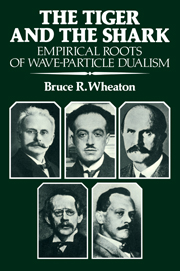Book contents
- Frontmatter
- Contents
- Foreword by Thomas S. Kuhn
- Preface
- Notes on sources
- 1 Introduction
- Part I The introduction of temporal discontinuity, 1896–1905
- Part II Ionization and the recognition of paradox, 1906–1910
- Part III Seeking an electrodynamic solution, 1907–1912
- Part IV Interference of x-rays and the corroboration of paradox, 1912–1922
- 8 Origins of x-ray spectroscopy
- 9 Quantum transformation experiments
- Part V The conceptual origins of wave–particle dualism, 1921–1925
- Epilogue: The tiger and the shark
- Bibliography
- Index
8 - Origins of x-ray spectroscopy
Published online by Cambridge University Press: 04 August 2010
- Frontmatter
- Contents
- Foreword by Thomas S. Kuhn
- Preface
- Notes on sources
- 1 Introduction
- Part I The introduction of temporal discontinuity, 1896–1905
- Part II Ionization and the recognition of paradox, 1906–1910
- Part III Seeking an electrodynamic solution, 1907–1912
- Part IV Interference of x-rays and the corroboration of paradox, 1912–1922
- 8 Origins of x-ray spectroscopy
- 9 Quantum transformation experiments
- Part V The conceptual origins of wave–particle dualism, 1921–1925
- Epilogue: The tiger and the shark
- Bibliography
- Index
Summary
[X-rays] are a kind of wave with properties no wave has any business to have.
In the spring of 1912 two research assistants in Munich directed an x-ray beam through a crystal and found that the beam was reformed into a well-defined interference pattern. The property most characteristic of periodic waves – their ability to interfere – is shared by the x-rays. Max Laue, the man chiefly responsible for the discovery, thought he had found proof that characteristic secondary x-rays from the crystal are periodic waves. But H. A. Lorentz quickly pointed out that impulses should interfere too. He showed, in a tour de force argument, that the accepted square pulse is an impossible representation of x-rays. William Henry Bragg and his son concluded that the interference maxima could, indeed, be due to irregular x-ray pulses. But, as such, x-ray impulses were not different from ordinary white light. They supported this claim with a new technique of crystal analysis fully analogous to ordinary optical spectroscopy.
Crystal diffraction provided a new tool for the analysis of x-rays. Pushed furthest by Henry Moseley and Charles Darwin, the technique soon showed that some x-rays comprise periodic wave trains of great length. The extremely sharp angular resolution of observed x-ray interference maxima indicated beyond doubt that x-rays are no different, except in frequency, from ordinary light. Rutherford soon extended the technique to the y-rays. Not only could one isolate characteristic γ-rays, he believed, one could show, with some effort, that they interfere too.
The successful integration of the new spectroscopy with the Bohr atom came, as had x-ray diffraction, from Sommerfeld's Munich.
- Type
- Chapter
- Information
- The Tiger and the SharkEmpirical Roots of Wave-Particle Dualism, pp. 199 - 232Publisher: Cambridge University PressPrint publication year: 1983



